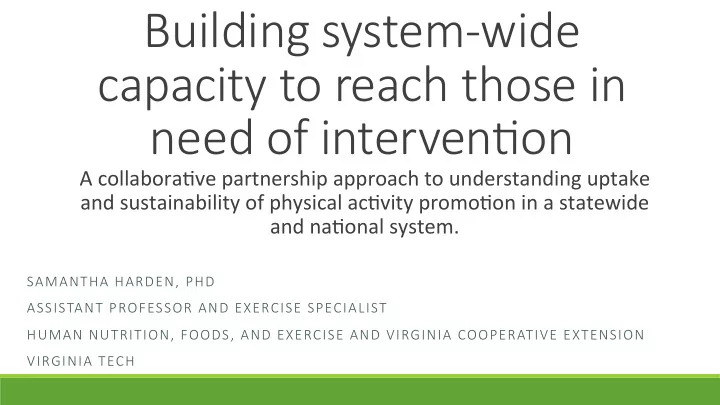

Building system-wide capacity to reach those in need of interven8on A collabora)ve partnership approach to understanding uptake and sustainability of physical ac)vity promo)on in a statewide and na)onal system. SAMANTHA HARDEN, PHD ASSISTANT PROFESSOR AND EXERCISE SPECIALIST HUMAN NUTRITION, FOODS, AND EXERCISE AND VIRGINIA COOPERATIVE EXTENSION VIRGINIA TECH
NITHYA RAMALINGAM REBECCA DAVIS IAN PASQUARELLI LINDA JACKSON COLE APRIL PAYNE EMILY WELLS CRYSTAL BARBER TERRI ABSTON REBECCA WILDER
Objec8ves ü Describe Coopera)ve Extension ü Share process and outcomes of establishing a research-prac)ce partnership with health educators of Coopera)ve Extension ü Demonstrate success of the partnership ü Results of two trials as evaluated by the RE-AIM framework (reach, effec)veness, adop)on, implementa)on, maintenance) ü Defend the use of a research-prac)ce partnership to increase the uptake and sustainability of interven)ons in prac)ce 3
Coopera8ve Extension Family and Consumer Available in every state and Sciences (FCS) founded in territory of the U.S. 1914 Mission is to bring Employ county-based FCS University-developed agents for health promoDon evidence to the people programming
Only 13 states include ‘physical acDvity’ outcomes in their strategic plan “This same system of Extension can do for the na)on’s health what it did for American agriculture.”
Typical Efficacy- Effec8veness- Dissemina8on Pipeline
Integrated Research-Prac8ce Partnership Model
Behavior change posi)vely impacts the organiza)on Need to shiP focus from individual- level targets(self-efficacy, effec)veness) to popula)on-level targets (uptake, sustainability)
NITHYA RAMALINGAM REBECCA DAVIS IAN PASQUARELLI LINDA JACKSON COLE APRIL PAYNE EMILY WELLS CRYSTAL BARBER TERRI ABSTON REBECCA WILDER
Adop8on Randomized Controlled Trial
“Those who delivered the programs were not significantly different on demographic or health- related characteris)cs as compared to those who did not deliver the program.” Harden, S.M., Johnson, S.B., Almeida, F.A. et al. Behav. Med. Pract. Policy Res. (2016). doi:10.1007/s13142-015-0380-6
Implementa)on • Time • FitEx took 134 ±162 h to deliver, or an average of 7 min per par)cipant • ALED took 33±49 h, or an average of 1.2 h per par)cipant. • Adapta)on • ALED None reported • Fit Ex Numerous small changes in feedback )ming and structure Harden, S.M., Johnson, S.B., Almeida, F.A. et al. Behav. Med. Pract. Policy Res. (2016). doi:10.1007/s13142-015-0380-6
Effec)veness FitEx ALED Overall FitEx (n= 81) (n=27) (n =1070) Inac)ve, % Baseline 37 37 29 Post-program 8 5 6 Insufficiently Ac)ve, % Baseline 28 28 36 Post-program 45 47 43 Ac)ve, % Baseline 35 35 35 Post-program 47 47 51 Harden, S.M., Johnson, S.B., Almeida, F.A. et al. Behav. Med. Pract. Policy Res. (2016). doi:10.1007/s13142-015-0380-6
Descrip)ve Informa)on Reach ALED > male ◦ Fit Ex ~75 par)cipants per health educator < work ours ◦ ALED ~15 par)cipants per health educator || WHY || Maintenance ◦ FitEx delivered for 3 years post ini)al evalua)on ◦ Health educators significantly more likely to intend to deliver the program in the following year when compared to their ALED counterparts Harden, S.M., Johnson, S.B., Almeida, F.A. et al. Behav. Med. Pract. Policy Res. (2016). doi:10.1007/s13142-015-0380-6
AN 8-WEEK, IN PERSON, GROUP-BASED STRENGTH-TRAINING PROGRAM TARGETING OLDER, SEDENTARY ADULTS Wilson M, Davis R, Harden SM. Informed adapta)ons of a group dynamics-based, strength-training program for older adults through a research-prac)ce partnership. Under Review: Health Promo)on Prac)ce
Founda8ons of LIFT Iden)fy a physical ac)vity program that promotes balance, flexibility, and strength training to improve funcDonal fitness, allowing older adults’ to age in place and live comfortably independent longer.
Agents who expressed interest in delivering strength-training SSSH AdopDon LIFT program Ramalingam N, & Harden SM. Obtaining T3 data using a sequen)al, transforma)ve mixed methods approach: What’s (n= 4) (n= 5) contribu)ng to the adop)on-implementa)on gap? ImplementaDon Decline Accept Poster Presenta)on: Wednesday, 5:30pm Decline Accept ( n= 2) ( n= 2) ( n= 1) ( n= 4) N = 113 parDcipants | 16 parDcipants per cohort Number of parDcipants per cohort, per agent Reach MacGhee M, Strayer III T, Harden SM. If you build it, will the target “they” come?: Reach, representa)veness, and reten)on of older adults in a community-based strength training program. Overall Program Cohort RetenDon Rate, % Mean +SD SSSH: 58+12 LIFT: 75 +10 Poster Presenta)on: Thursday, 11:15am Age, BMI, Sex, Ethnicity were similar across the two condiDons. There were RepresentaDveness Maintenance EffecDveness significantly more (P <.0.05) African American parDcipants in SSSH. EffecDveness: Presented on next slide 0% Intend to Deliver [all intend to deliver LIFT] 100% Intend to Deliver in 2017
Pre and Post-Program Strength, Flexibility, and Balance Scores, by program Func)onal Fitness Assessment Program Baseline Post-program (ITT) Change scores Sit and Stands M(±SD) LIFT 10.58 (±3.21) 13.07 (±5.14)* 2.67 (±3.73)* SSSH 9.40 (±4.29) 10.71 (±3.22) 1.31 (±2.17)* Arm Curls M(±SD) LIFT 13.89 (±4.0) 17.65 (±6.22) 3.65 (±6.03)* SSSH 14.50 (±5.55) 15.9 (±4.3) 1.40(±6.37) 2-minute step test M(±SD) LIFT 61.66 (±30.0) 77.5 (±30.0) 14.03 (±16.71)* SSSH 52.6 (±22.6) 72.4 (±32.3) 20.33 (±33.09)* Lower body flexibility M(±SD) LIFT 1.74 (±3.86) -0.000 3(±2.96) 1.77 (±2.97)* SSSH -0.76 (±3.12) 0.68 (±3.05) 1.44 (±2.53)* Upper body flexibility M(±SD) LIFT -5.05 (±4.93) -4.2 (±5.51) 1.24 (±3.17)* SSSH -6.05 (±5.69) -4.8 (±4.06) 1.25 (±1.94)* 8-foot up-and-go M(±SD) LIFT 7.68 (±3.84) 7.02 (±3.25) -.065 (±1.31)* SSSH 7.19 (±2.92) 6.6 (±1.94) -0.06 (±1.97) Composite balance score M(±SD) LIFT 2.44 (±1.3) 2.79 (±1.5) 0.35 (±1.18)* *p<0.05 SSSH 2.00 (±1.0) 2.42 (±1.4) 0.42 (±0.99)* ITT: Inten)on to Treat; Paired T-test, within program significant differences (* p <0.05); One way ANOVA analysis did not detect any significant differences between programs.
Implica8ons Building a collabora)ve partnership allows community Iden)fica)on of organiza)onal health workers to contribute to culture, needs, and resources is the development and design of impera)ve to ensure program interven)ons that may be uptake and sustainability. tailored for the audiences they serve. Future research is needed on the collec)ve impact the partnership and its efforts will have on popula)on-level physical ac)vity changes.
Ques8ons? Thank you! Thanks to all PALT and PARCI members!
Recommend
More recommend